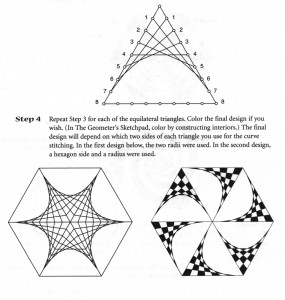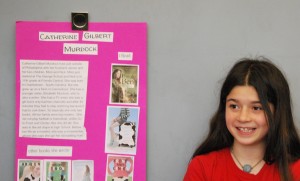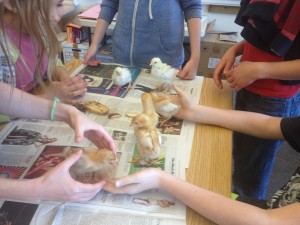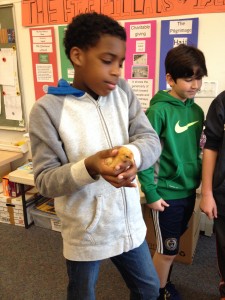One of the things we have been doing in various ways through the year is developing students’ vocabularies. We stop to discuss words and phrases when we are reading fiction aloud and when we are reading novels in small groups. We do focused lessons on words that relate to classroom activities such as math and social studies. And we do worksheets from several resources that strengthen students’ understanding of common prefixes, suffixes, and roots. (Those worksheets have been what we have been doing lately.)We speak of that collection of word parts as being a kind of verbal Lego — building blocks that can be assembled in many different ways. One of the things that is very clear to us is that formal definitions are often insufficient for understanding. That is, vocabulary needs conversation, and Mark and I provide that conversation as students do the work. Sometimes we chat with individual students, and sometimes we share the question and our response with the whole class. The advice to “look it up in the dictionary” is usually not very effective. Students need to know the meaning that is relevant to the current need, not a dozen different ways that a word such as pitch might be defined. They may need some help with grammar — is that word an adjective that needs to be accompanied by the noun it describes? Perhaps it’s a transitive verb that needs an object to make complete sense. It might be a word that is pejorative and therefore to be used very carefully. So we encourage you to stop and talk with your child when s/he comes to you with a vocabulary question. It’s a lot more effective than being sent to a dictionary.
We finished our work with geometry constructions on Thursday. We may find time to return to it before the end of the year, but there is a lot left in our plans. Most students enjoyed the unit. They became more adept at working with hand tools, came to a strong appreciation of what ancient people did with the same tools, and understood more of what Geometer’s Sketchpad seems to do so magically. We connected it specifically with the kinds of geometric decorative art found in areas to which Islam was spread — from the Middle East to Spain and beyond as Spanish colonists carried the style to the New World. We did some coloring of tessellated designs based on Islamist decorative tiles from hundreds of years ago, seeing how the same basic patterns could be used to yield many different final designs.
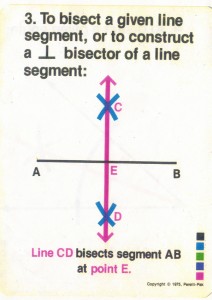
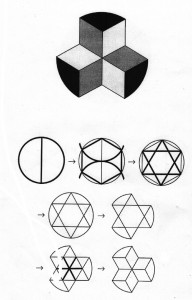
Part of the challenge of this unit was to work with spatial relationships that were not quantified: construct a perpendicular bisector of a segment without measuring the segment or the angle, bisect an angle, copy a triangle, and more. The guide sheets we used were essentially wordless beyond stating the goal — students needed to analyze the diagrams and do the steps in sequence.
At the end of the unit, we did some “curve stitching” within various polygons, seeing how the same shape could be “stitched” in different ways (images at right). Students always find this very satisfying and quickly catch on to the linkage patterns that must be followed.
One of our most important “social” studies is the one we call “Changes and Choices.” It encompasses a lot of topics: peer pressure (both positive and negative); body systems and puberty; sexually transmitted diseases; identity and the many ways we are “perfectly” normal; sustaining healthy relationships with family and friends; understanding the effects of tobacco, alcohol, and many drugs (both “street” and legal); appropriate use of social media and what to do when it goes wrong; and much more. We hope that your children are coming home with questions that they may not have asked in class.
Part of our study of the foundations of Islam includes stories. I’ve started reading aloud some of the 1,oo1 Arabian Nights by Geraldine McCaughrean and Rosamund Fowler. Students are enjoying the tales, seeing connections with what we have been learning about Muslim beliefs and practices, and recognizing some stories and characters (such as Sinbad) that they thought were modern fiction. Another thing we did this week was research some inventions and discoveries that are sometimes credited to the Muslims. Each student was given a topic (vaccination, coffee, cameras, algebra, fountain pens, robotics, gunpowder, and more) and tried to find out what connection these things actually had with the Muslim world. Some were clearly attributable; some were not original but were developed and improved, and some were apparently not connected with Muslims except by mistaken belief. It was a good short project that demonstrated the importance of d0ing research in more than a single source.
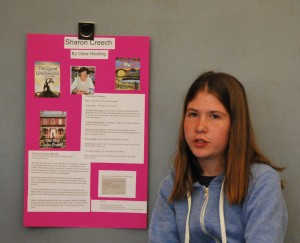
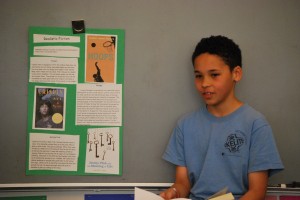
Students presented their independent reading projects to classmates during the week. There was a broad assortment of authors and genres; everyone seemed to be pleased with their choices and seemed confident and relaxed while talking to the group. Some worked on schedule and were ready on Monday (or sooner). Others were still finishing their poster and talk during choice times right on through Thursday, but everyone got there eventually.
And our chicks came to school on Monday. Four are “sex-link” hens whose color indicate their gender: females are red and males are white. These chickens are like the ones we had at the start of the year — prolific layers now part of the flock at my house so we could get our rat population under control. The other two are a relatively new hybrid called “tetra tints” and are supposed to lay cream-colored eggs. Students in our building are observing rapid growth and near-daily physical changes in the chicks as they go from downy fluff to increasing feathers. They still need to be kept indoors and warm, but they’ll be going outside to the renovated pen by the end of the year. Camp will enjoy them over the summer, and we’ll start collecting and selling eggs in the fall. The important job now is teaching them to trust and be friendly toward people. Lots of gentle chick handling is going on at choice time, and we are seeing personality differences not only between the two breeds but also in individual birds.

